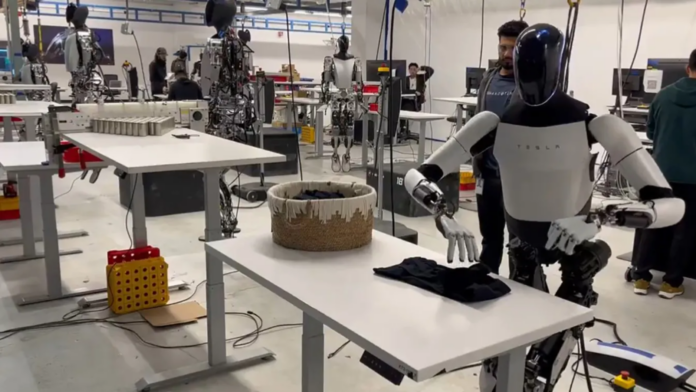In the ever-evolving world of robotics, Tesla’s latest demonstration featuring Elon Musk’s brainchild, the Optimus humanoid robot, has garnered mixed reactions. The recent showcase involved Optimus adeptly folding a T-shirt on a table. While the robot displayed a certain level of proficiency in this mundane task, Musk’s subsequent comments have stirred up a debate about the true capabilities and future potential of this robotic venture.
Firstly, it’s clear that while Optimus can handle a T-shirt, it’s not setting any speed records in the laundry-folding department. But speed isn’t the crux of the matter. The more significant revelation was that Optimus wasn’t operating autonomously during this demo. Instead, it was more akin to a high-tech puppet, programmed to follow a set of predetermined actions. This approach, while impressive in showcasing the mechanical finesse of the robot’s joints and limbs, doesn’t quite hit the mark in terms of artificial intelligence or autonomous functionality.
Tesla, under Musk’s direction, has made significant strides in various technological domains, and their releases often dazzle with the sheer ingenuity of engineering. However, this latest demonstration with Optimus seems to toe the line between showcasing potential and masking current limitations. The controlled environment of the demo — a fixed-height table and a single, strategically placed item of clothing — highlights the current constraints rather than the robot’s adaptability or intelligence.
Musk’s assertion that Optimus will eventually operate fully autonomously, free from the shackles of a scripted performance, is an ambitious goal. Achieving this level of functionality would indeed be a breakthrough in domestic robotics. However, considering the current state of robotic technology, this aspiration seems like a distant goal rather than an imminent reality.
The task of manipulating soft materials like clothing in a human-like manner is a complex challenge in robotics. The finesse required to mimic human interaction with such objects is a testament to Tesla’s advanced animatronics and engineering. Yet, equating this achievement with the creation of a fully functional domestic robot capable of replacing human domestic workers is a stretch. It’s akin to comparing the motions of a wooden marionette to the fluid movements of a real human being.
Musk’s timeline for Optimus, suggesting a fully operational version in three to five years, is optimistic at best. His track record of ambitious predictions is well-known, but the gap between the current capabilities of Optimus and the envisioned future of a fully autonomous domestic robot is significant.
In conclusion, while the Optimus robot’s laundry-folding demo is a step forward in showcasing robotic capabilities, it’s more a display of potential than a leap into the future of home automation. The road to a fully autonomous domestic robot is long and fraught with challenges. The demonstration with Optimus highlights the current state of robotics — impressive in its technological prowess, but still a far cry from the autonomous, intelligent machines that have long been a staple of science fiction. The future of domestic robotics is certainly exciting, but for now, it remains firmly in the realm of gradual progress rather than revolutionary leaps.












